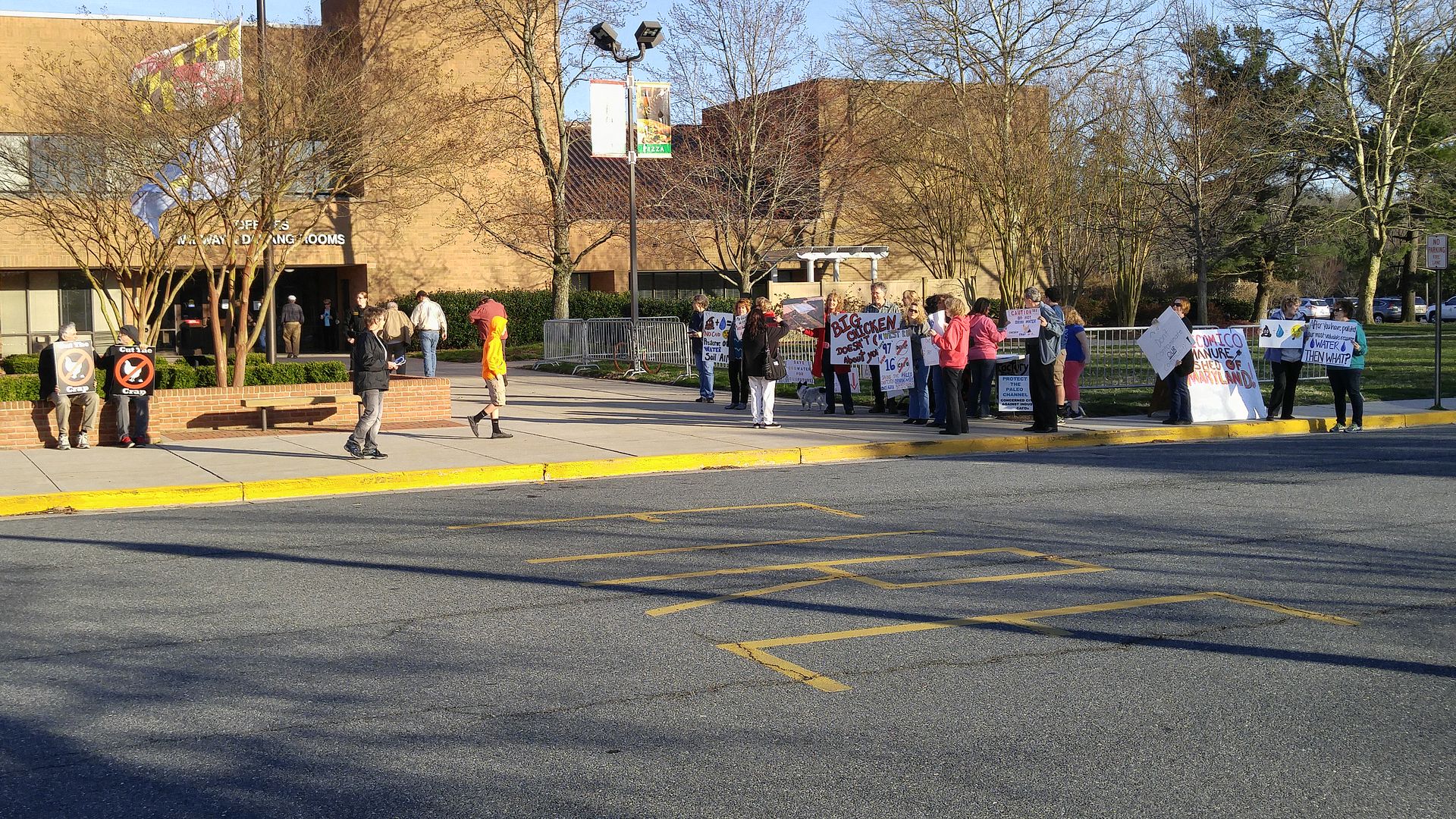After controversy about the prospect of large poultry operations with multiple chicken houses (up to a baker’s dozen in one case) as well as concern over the paleochannel that runs near the Salisbury area, County Executive Bob Culver organized a public meeting held earlier this evening to discuss some of these concerns with a number of state officials. Ten representatives, mainly from the Maryland Department of the Environment (MDE) but also representing the Department of Agriculture and the Department of Health and Mental Hygiene (DHMH), were made available to answer questions from a large audience of onlookers.

Culver assured the audience that there were “no predetermined outcomes from this forum,” stressing that the idea was to explore the impact these operations would have on groundwater and the paleochannel, along with the possibility of airborne toxins. Culver noted that a Daily Times editorial penned by local activist Judith Stribling called on us to be “determined to avoid polarization,” and the crowd inside complied.
Outside? Well, that was a different story.

I shared this on social media, noting the anti-poultry zealots had arrived. Yet that band of perhaps three dozen was no more than a fraction of those inside. And it’s a sure bet that many thousands more will be alerted to the results of this meeting on local media.

Needless to say, once moderator Greg Bassett of the Salisbury Independent opened up the questions, which were written by audience members and passed to the front of the room, we had a lot of queries about how the operations would affect the water supply as well as the disposition of the natural by-products of the poultry.
In fact, the first question out of the chute was on how the PMT regulations were affecting the capacity of the land to handle manure. Dave Mister of the Department of Agriculture told those gathered that “we feel there will be adequate land to apply manure.” One thing he didn’t add was that much of the lower Shore has reached its saturation point for phosphorus, so that waste would need to be transported.
But the main thrust of the questioners regarding the waste itself was the effects it would have on peoples’ health. There were no “cancer clusters” being caused by these operations, said Dr. Clifford Mitchell of DHMH. Asthma from airborne particulates could be an issue, but that depended more on the individual and poultry operations couldn’t be blamed as a blanket cause.
The only possible issue could be nitrates in the water supply, which is regulated by the federal EPA to prevent what’s called “blue baby syndrome.” There is no regulation for phosphorus, added John Grace of MDE.
Moreover, the panel agreed health or environmental issues shouldn’t be a problem as long as the operation is run according to permit requirements. The idea is “zero discharge,” said Gary Kelman of the MDE. “No discharge will occur…if the permit is adhered to,” Kelman added. We also learned that they inspect based on complaints, and “we have lots of eyes out there,” said Kelman. Operations are inspected every five years at the minimum, but more often if there are complaints.
This to me may be an Achilles heel for the industry, since those who want to stir up trouble can make it difficult for CAFOs (short for concentrated animal feeding operations) to survive a week without some inspection. (To be considered a CAFO, a grower has to deal with 37,500 or more birds.)
And while they couldn’t answer a question dealing with the carrying capacity of our local industry, Mister admitted the number of chickens being grown was probably increasing. “The industry is growing, and that’s a good thing,” said Mister. The industry has to expand to be successful.
It was interesting to me that one of the more asinine questions was what they would do to protect smaller farmers; a question that received a smattering of applause. Mister simply said that was “best answered by the industry.” But on a compliance basis, he noted that all farmers have issues yet they get “phenomenal” cooperation from growers when there are problems.
We went almost the first hour without getting a question about the paleochannel, but one finally came. And the consensus was that there was “little chance” the paleochannel would be affected by these operations because they were all under roof – even the mortality composters were protected from the elements. In the event of a catastrophic loss, there was also the option of using the manure storage shed. There seems to be a lot of redundancy in the operation as well as in the permitting process.
That process also was a concern of some questioners, who worried that there was an effort to “fast-track” approvals. But the idea was to process them as efficiently as possible, protested Hussein Alhija of MDE, who noted “my job is to improve the process.” Several different state entities have to work in conjunction to get these permits in order. It’s a “very complex process.” noted Mister, who added that education on permitting was important. Kelman chimed in by pointing out lenders need the permits in order to fund the operations.
Nor is the paleochannel in danger from the water usage required by these operations. Poultry growing uses “several orders of magnitude” less water than cropland operations, said Grace. In fact, there is “no declining water level” in the aquafers. “We’re okay as far as the water supply goes,” Grace assessed.
Yet while the answers seemed to be satisfactory regarding water quality and permitting, those who thought CAFOs could be eliminated from being adjacent to residential areas were likely disappointed. The only standard that applies as far as the state is concerned is that operations must be 1oo feet away from “waters of the state.” Otherwise, Kelman conceded that it “seems to be a local zoning issue.” Given that residential development is oftentimes adjacent to land zoned agricultural, that will be something the county would need to address.
And there will still be people who are aggravated, even with all the assurances from the state group.

Perhaps the creator of this sign is related to the late William Donald Schaefer, the onetime governor who called the Eastern Shore the “shithouse” of Maryland.
In about an hour and a half, though, we all got a little understanding about the permitting process prospective growers have to go through, and perhaps it’s the idea that dealing with one big farm and one permit rather than several operations that is making the large-scale farms the better business model.
In his introduction, Culver noted there are 2,300 employees of local poultry companies. That’s a decent percentage of the local workforce, and it doesn’t count the ancillary jobs created by the need for these employees to live their lives. If the supply chain of chicken dries up, there will be a significant impact to our local economy that low-impact tourism can’t replace.
Given the evidence that the state of Maryland is trying to be of assistance to growers in maintaining a clean environment, the only explanation for the opposition is that it’s being whipped up by Radical Green, with the paleochannel just an excuse to stop vital development. With the steps being taken to treat stormwater and precautions being taken to keep farm operations as environmentally friendly as possible, I think that chicken growers are trying to be the best neighbors they can – it’s the outside extremists who are trying to foul our economic nest.

